Fundamentals of Marketing: Maliban's Marketing Environment Analysis
VerifiedAdded on 2022/07/26
|18
|3535
|71
Report
AI Summary
This report provides a detailed analysis of the marketing environment of Maliban, a prominent Sri Lankan biscuit manufacturer. It explores the internal, micro, and macro environmental factors influencing the company, including a PEST analysis to assess political, economic, social, and technological factors. The report delves into consumer behavior, examining the buying decision process and characteristics influencing consumer choices. Furthermore, it analyzes Maliban's market segmentation, targeting, and positioning (STP) strategy, and evaluates the company's marketing mix, including pricing, distribution, and promotion strategies. The report concludes by summarizing key findings and insights into Maliban's marketing practices and their effectiveness in the competitive biscuit market.
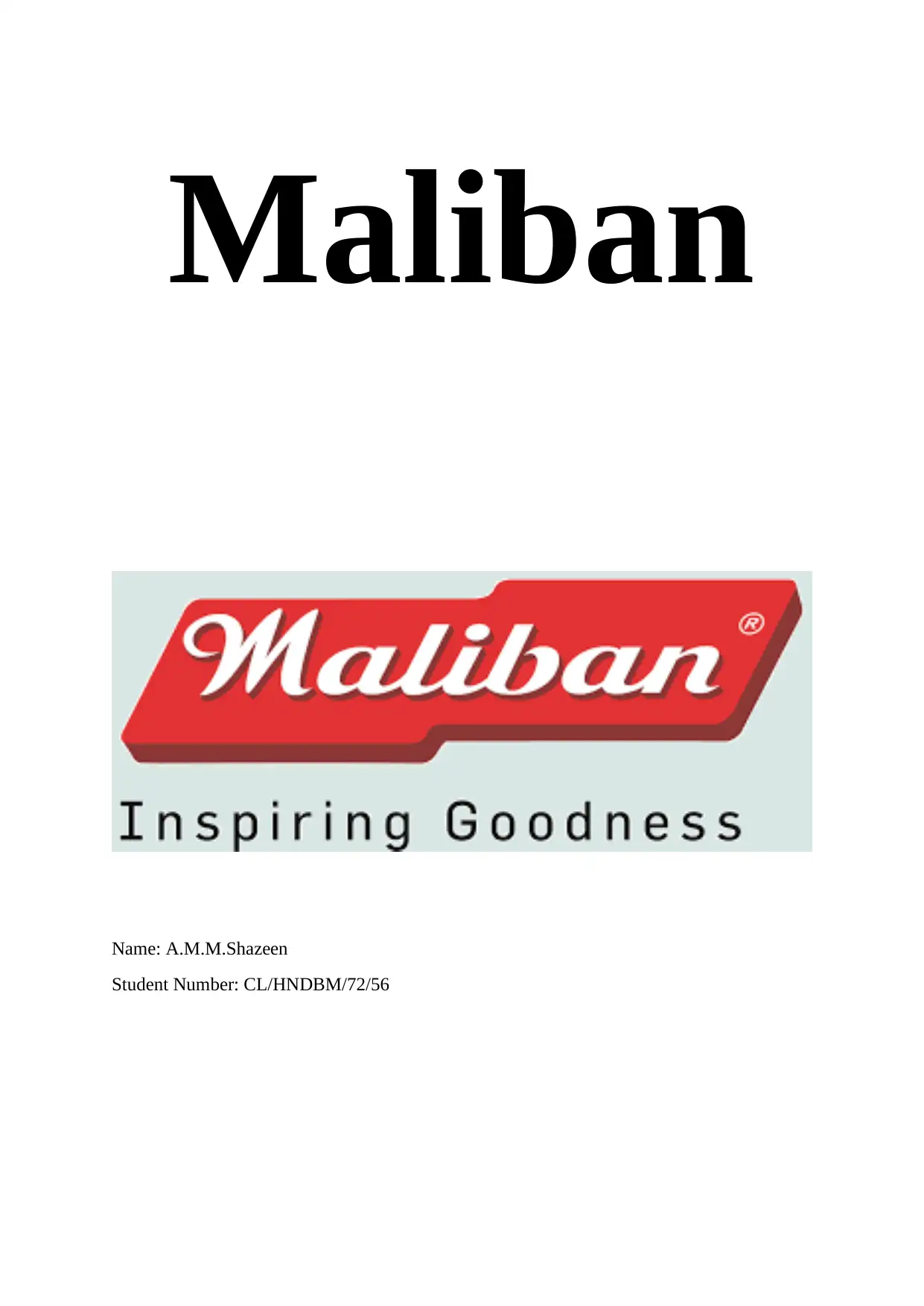
Maliban
Name: A.M.M.Shazeen
Student Number: CL/HNDBM/72/56
Name: A.M.M.Shazeen
Student Number: CL/HNDBM/72/56
Paraphrase This Document
Need a fresh take? Get an instant paraphrase of this document with our AI Paraphraser
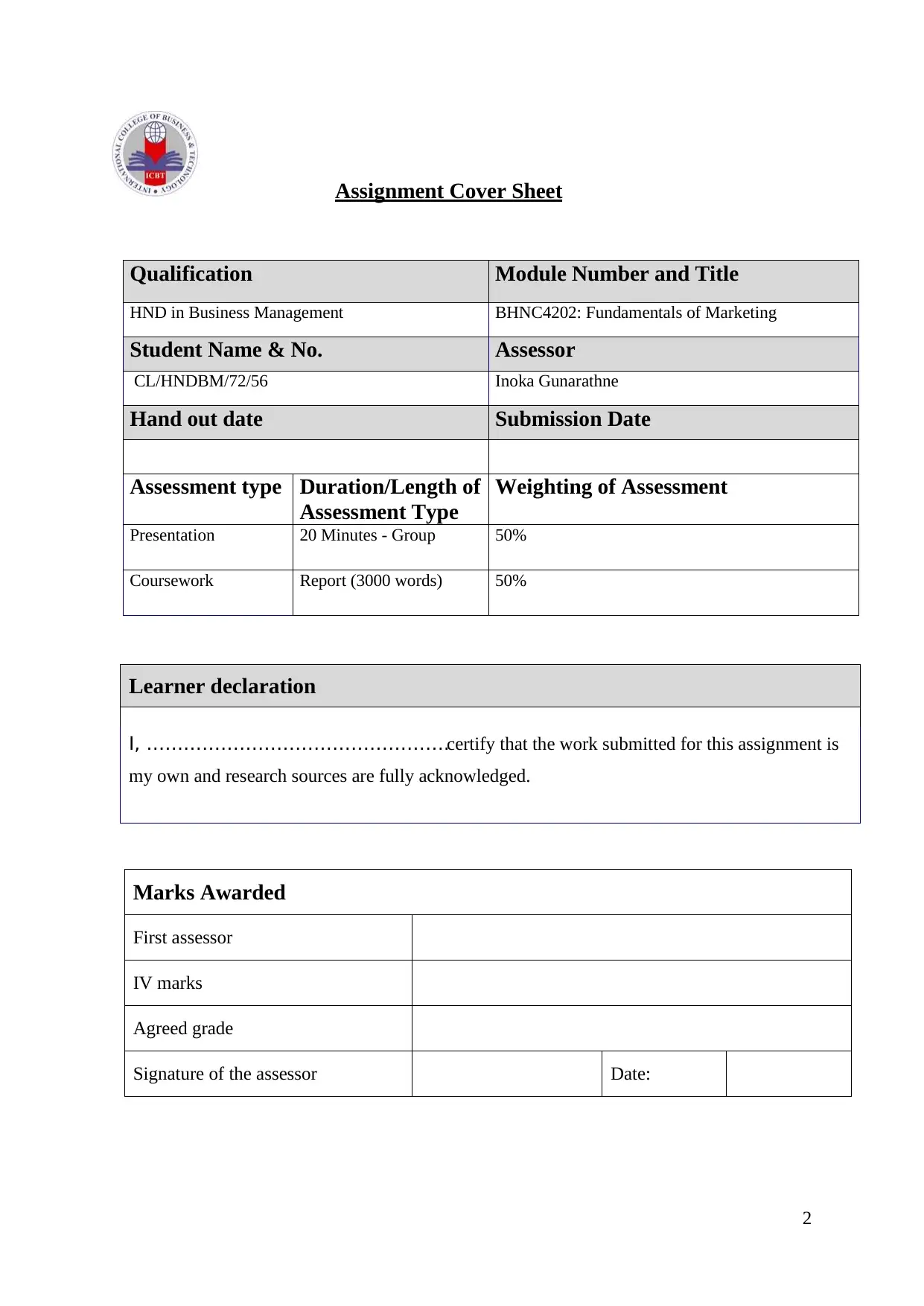
2
Assignment Cover Sheet
Qualification Module Number and Title
HND in Business Management BHNC4202: Fundamentals of Marketing
Student Name & No. Assessor
CL/HNDBM/72/56 Inoka Gunarathne
Hand out date Submission Date
Assessment type Duration/Length of
Assessment Type
Weighting of Assessment
Presentation 20 Minutes - Group 50%
Coursework Report (3000 words) 50%
Learner declaration
I, ………………………………………….certify that the work submitted for this assignment is
my own and research sources are fully acknowledged.
Marks Awarded
First assessor
IV marks
Agreed grade
Signature of the assessor Date:
Assignment Cover Sheet
Qualification Module Number and Title
HND in Business Management BHNC4202: Fundamentals of Marketing
Student Name & No. Assessor
CL/HNDBM/72/56 Inoka Gunarathne
Hand out date Submission Date
Assessment type Duration/Length of
Assessment Type
Weighting of Assessment
Presentation 20 Minutes - Group 50%
Coursework Report (3000 words) 50%
Learner declaration
I, ………………………………………….certify that the work submitted for this assignment is
my own and research sources are fully acknowledged.
Marks Awarded
First assessor
IV marks
Agreed grade
Signature of the assessor Date:
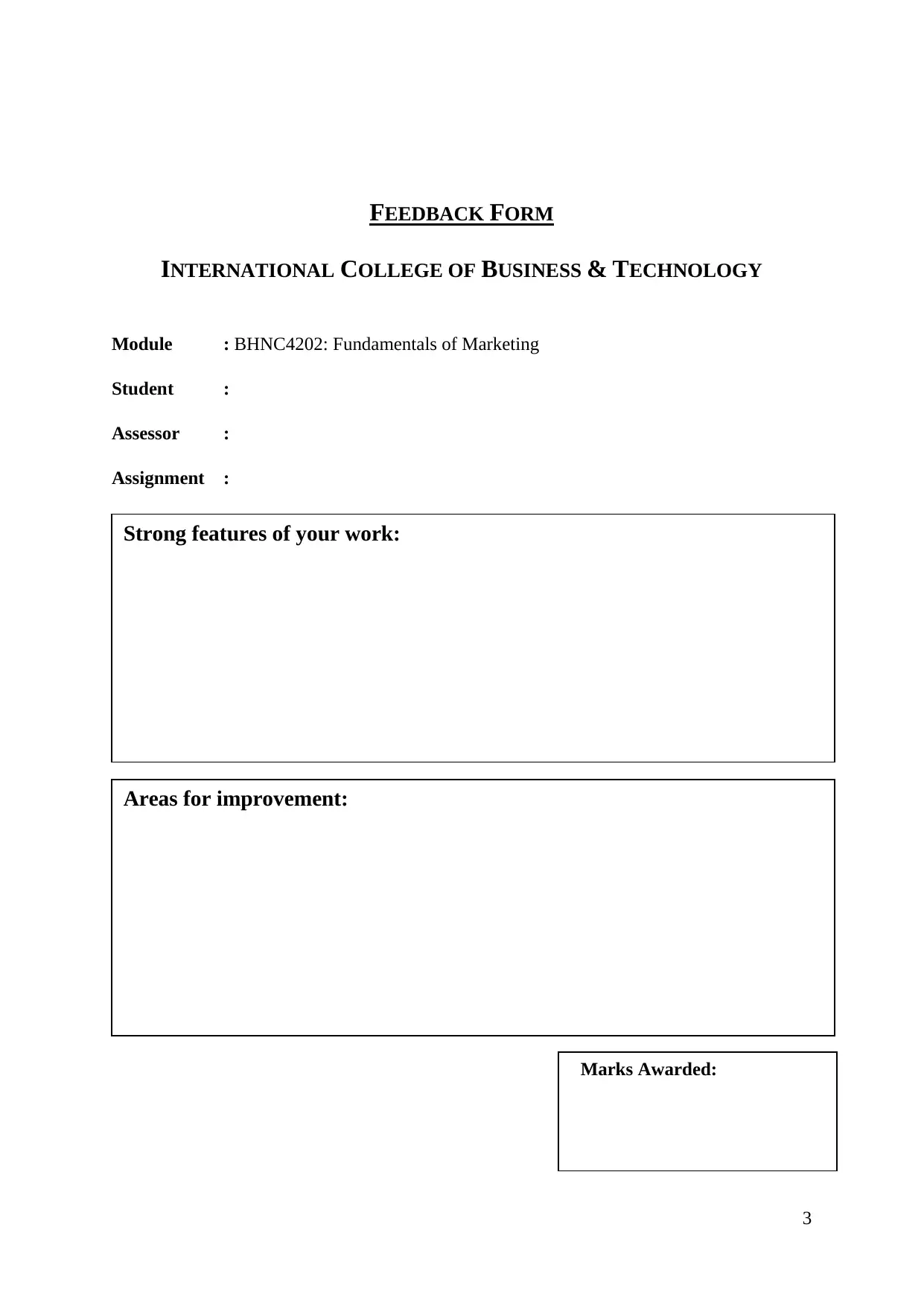
3
FEEDBACK FORM
INTERNATIONAL COLLEGE OF BUSINESS & TECHNOLOGY
Module : BHNC4202: Fundamentals of Marketing
Student :
Assessor :
Assignment :
Strong features of your work:
Areas for improvement:
Marks Awarded:
FEEDBACK FORM
INTERNATIONAL COLLEGE OF BUSINESS & TECHNOLOGY
Module : BHNC4202: Fundamentals of Marketing
Student :
Assessor :
Assignment :
Strong features of your work:
Areas for improvement:
Marks Awarded:
⊘ This is a preview!⊘
Do you want full access?
Subscribe today to unlock all pages.

Trusted by 1+ million students worldwide
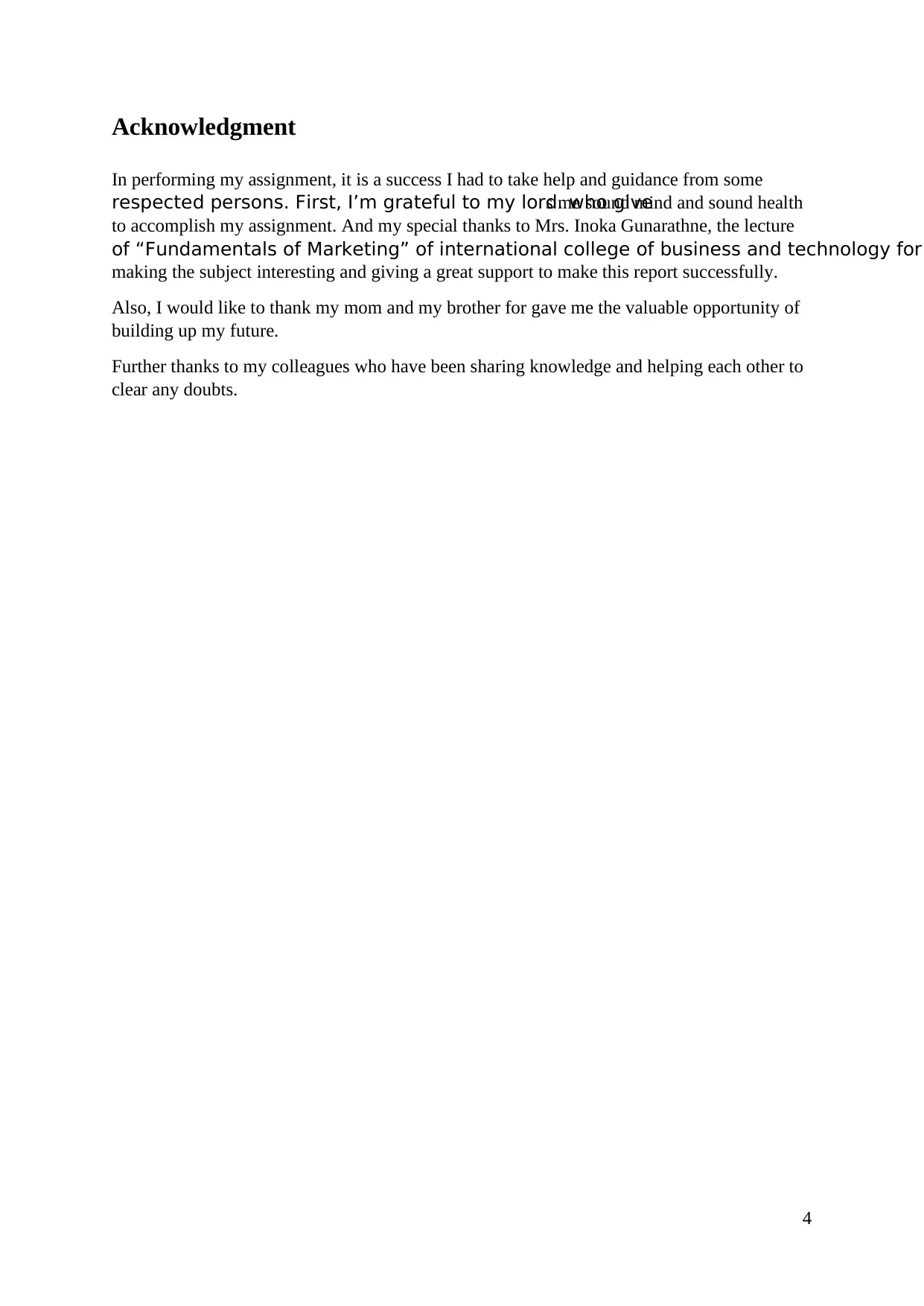
4
Acknowledgment
In performing my assignment, it is a success I had to take help and guidance from some
respected persons. First, I’m grateful to my lord. who gives me sound mind and sound health
to accomplish my assignment. And my special thanks to Mrs. Inoka Gunarathne, the lecture
of “Fundamentals of Marketing” of international college of business and technology for
making the subject interesting and giving a great support to make this report successfully.
Also, I would like to thank my mom and my brother for gave me the valuable opportunity of
building up my future.
Further thanks to my colleagues who have been sharing knowledge and helping each other to
clear any doubts.
Acknowledgment
In performing my assignment, it is a success I had to take help and guidance from some
respected persons. First, I’m grateful to my lord. who gives me sound mind and sound health
to accomplish my assignment. And my special thanks to Mrs. Inoka Gunarathne, the lecture
of “Fundamentals of Marketing” of international college of business and technology for
making the subject interesting and giving a great support to make this report successfully.
Also, I would like to thank my mom and my brother for gave me the valuable opportunity of
building up my future.
Further thanks to my colleagues who have been sharing knowledge and helping each other to
clear any doubts.
Paraphrase This Document
Need a fresh take? Get an instant paraphrase of this document with our AI Paraphraser
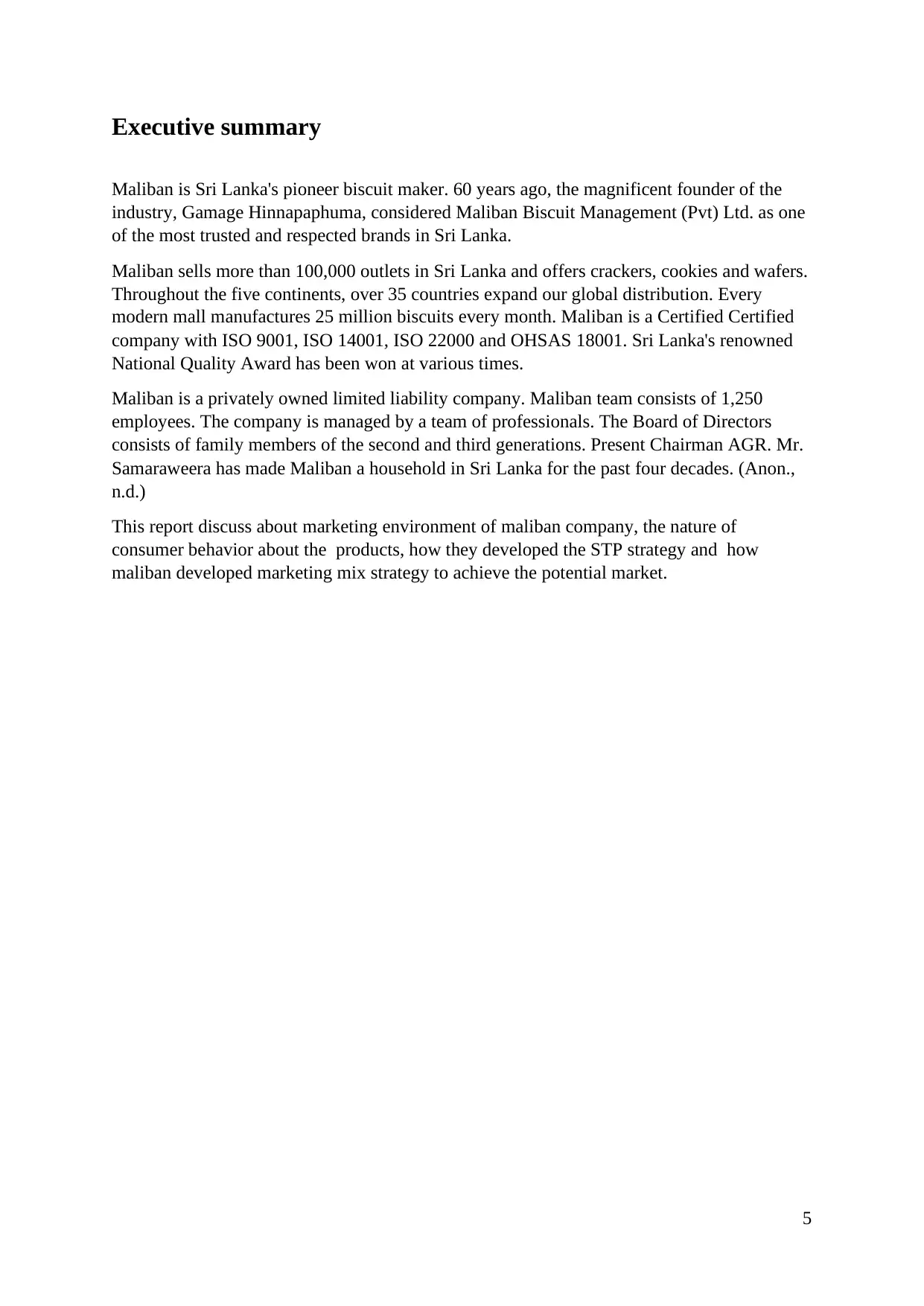
5
Executive summary
Maliban is Sri Lanka's pioneer biscuit maker. 60 years ago, the magnificent founder of the
industry, Gamage Hinnapaphuma, considered Maliban Biscuit Management (Pvt) Ltd. as one
of the most trusted and respected brands in Sri Lanka.
Maliban sells more than 100,000 outlets in Sri Lanka and offers crackers, cookies and wafers.
Throughout the five continents, over 35 countries expand our global distribution. Every
modern mall manufactures 25 million biscuits every month. Maliban is a Certified Certified
company with ISO 9001, ISO 14001, ISO 22000 and OHSAS 18001. Sri Lanka's renowned
National Quality Award has been won at various times.
Maliban is a privately owned limited liability company. Maliban team consists of 1,250
employees. The company is managed by a team of professionals. The Board of Directors
consists of family members of the second and third generations. Present Chairman AGR. Mr.
Samaraweera has made Maliban a household in Sri Lanka for the past four decades. (Anon.,
n.d.)
This report discuss about marketing environment of maliban company, the nature of
consumer behavior about the products, how they developed the STP strategy and how
maliban developed marketing mix strategy to achieve the potential market.
Executive summary
Maliban is Sri Lanka's pioneer biscuit maker. 60 years ago, the magnificent founder of the
industry, Gamage Hinnapaphuma, considered Maliban Biscuit Management (Pvt) Ltd. as one
of the most trusted and respected brands in Sri Lanka.
Maliban sells more than 100,000 outlets in Sri Lanka and offers crackers, cookies and wafers.
Throughout the five continents, over 35 countries expand our global distribution. Every
modern mall manufactures 25 million biscuits every month. Maliban is a Certified Certified
company with ISO 9001, ISO 14001, ISO 22000 and OHSAS 18001. Sri Lanka's renowned
National Quality Award has been won at various times.
Maliban is a privately owned limited liability company. Maliban team consists of 1,250
employees. The company is managed by a team of professionals. The Board of Directors
consists of family members of the second and third generations. Present Chairman AGR. Mr.
Samaraweera has made Maliban a household in Sri Lanka for the past four decades. (Anon.,
n.d.)
This report discuss about marketing environment of maliban company, the nature of
consumer behavior about the products, how they developed the STP strategy and how
maliban developed marketing mix strategy to achieve the potential market.
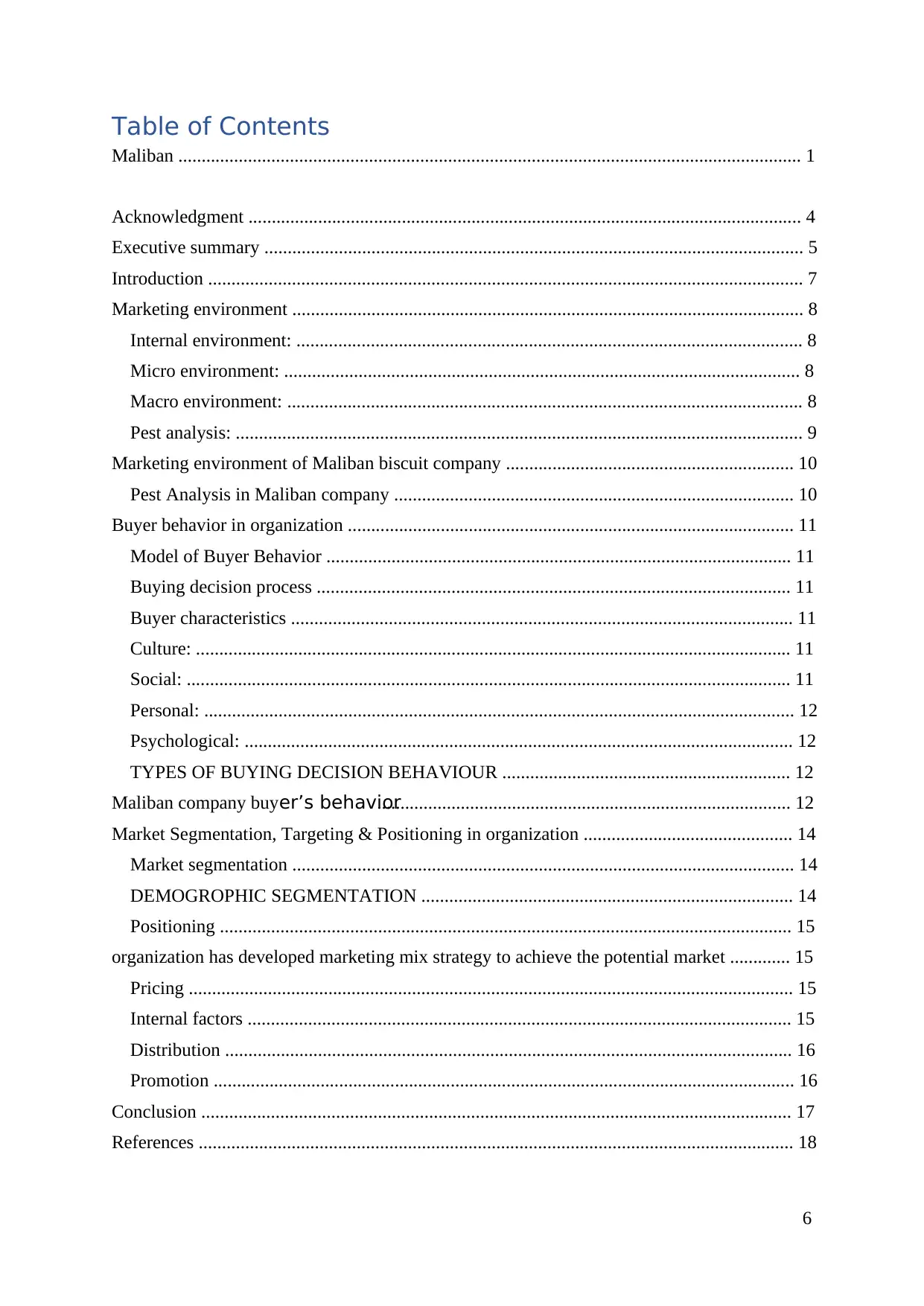
6
Table of Contents
Maliban ...................................................................................................................................... 1
Acknowledgment ....................................................................................................................... 4
Executive summary .................................................................................................................... 5
Introduction ................................................................................................................................ 7
Marketing environment .............................................................................................................. 8
Internal environment: ............................................................................................................. 8
Micro environment: ............................................................................................................... 8
Macro environment: ............................................................................................................... 8
Pest analysis: .......................................................................................................................... 9
Marketing environment of Maliban biscuit company .............................................................. 10
Pest Analysis in Maliban company ...................................................................................... 10
Buyer behavior in organization ................................................................................................ 11
Model of Buyer Behavior .................................................................................................... 11
Buying decision process ...................................................................................................... 11
Buyer characteristics ............................................................................................................ 11
Culture: ................................................................................................................................ 11
Social: .................................................................................................................................. 11
Personal: ............................................................................................................................... 12
Psychological: ...................................................................................................................... 12
TYPES OF BUYING DECISION BEHAVIOUR .............................................................. 12
Maliban company buyer’s behavior......................................................................................... 12
Market Segmentation, Targeting & Positioning in organization ............................................. 14
Market segmentation ............................................................................................................ 14
DEMOGROPHIC SEGMENTATION ................................................................................ 14
Positioning ........................................................................................................................... 15
organization has developed marketing mix strategy to achieve the potential market ............. 15
Pricing .................................................................................................................................. 15
Internal factors ..................................................................................................................... 15
Distribution .......................................................................................................................... 16
Promotion ............................................................................................................................. 16
Conclusion ............................................................................................................................... 17
References ................................................................................................................................ 18
Table of Contents
Maliban ...................................................................................................................................... 1
Acknowledgment ....................................................................................................................... 4
Executive summary .................................................................................................................... 5
Introduction ................................................................................................................................ 7
Marketing environment .............................................................................................................. 8
Internal environment: ............................................................................................................. 8
Micro environment: ............................................................................................................... 8
Macro environment: ............................................................................................................... 8
Pest analysis: .......................................................................................................................... 9
Marketing environment of Maliban biscuit company .............................................................. 10
Pest Analysis in Maliban company ...................................................................................... 10
Buyer behavior in organization ................................................................................................ 11
Model of Buyer Behavior .................................................................................................... 11
Buying decision process ...................................................................................................... 11
Buyer characteristics ............................................................................................................ 11
Culture: ................................................................................................................................ 11
Social: .................................................................................................................................. 11
Personal: ............................................................................................................................... 12
Psychological: ...................................................................................................................... 12
TYPES OF BUYING DECISION BEHAVIOUR .............................................................. 12
Maliban company buyer’s behavior......................................................................................... 12
Market Segmentation, Targeting & Positioning in organization ............................................. 14
Market segmentation ............................................................................................................ 14
DEMOGROPHIC SEGMENTATION ................................................................................ 14
Positioning ........................................................................................................................... 15
organization has developed marketing mix strategy to achieve the potential market ............. 15
Pricing .................................................................................................................................. 15
Internal factors ..................................................................................................................... 15
Distribution .......................................................................................................................... 16
Promotion ............................................................................................................................. 16
Conclusion ............................................................................................................................... 17
References ................................................................................................................................ 18
⊘ This is a preview!⊘
Do you want full access?
Subscribe today to unlock all pages.

Trusted by 1+ million students worldwide
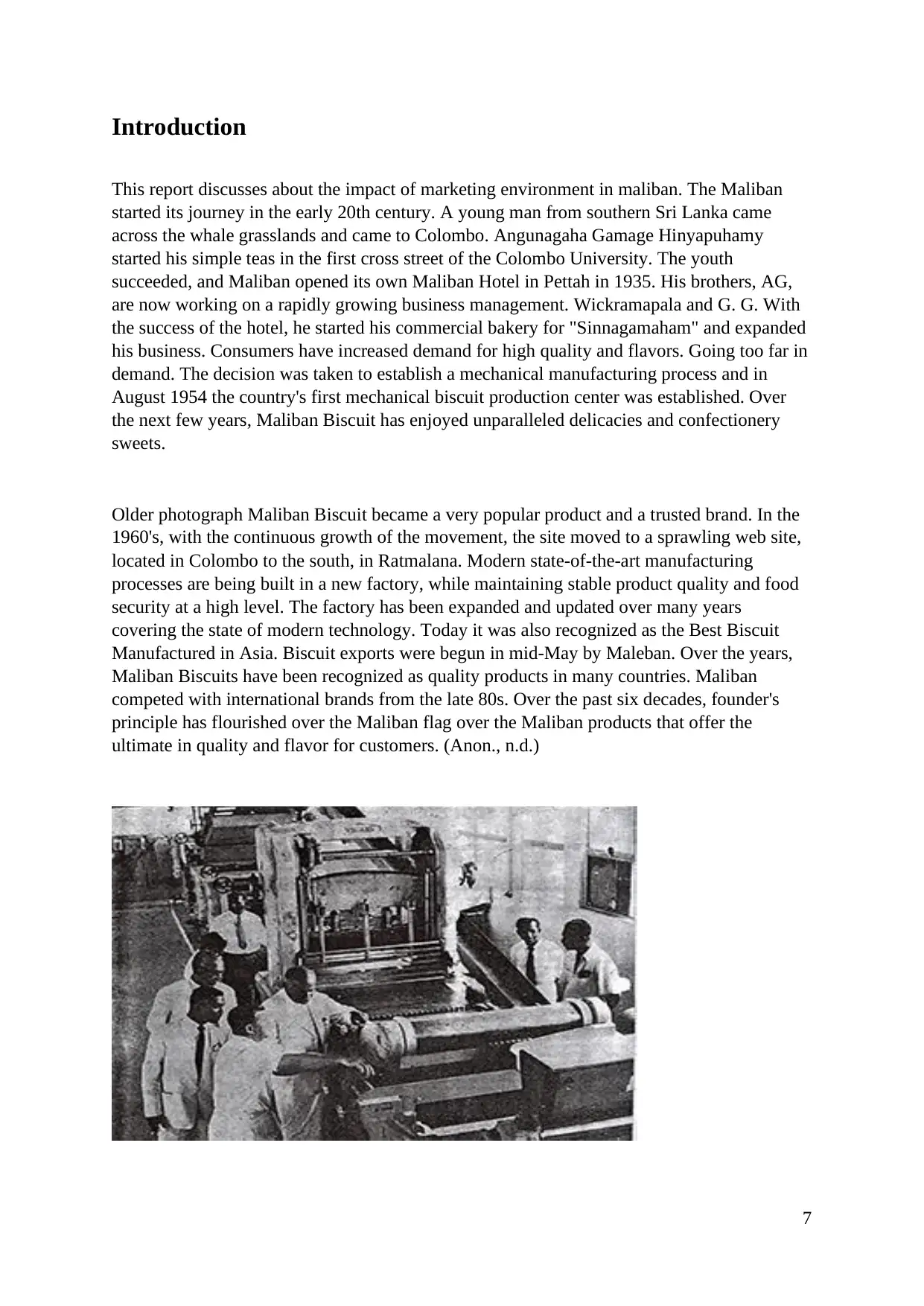
7
Introduction
This report discusses about the impact of marketing environment in maliban. The Maliban
started its journey in the early 20th century. A young man from southern Sri Lanka came
across the whale grasslands and came to Colombo. Angunagaha Gamage Hinyapuhamy
started his simple teas in the first cross street of the Colombo University. The youth
succeeded, and Maliban opened its own Maliban Hotel in Pettah in 1935. His brothers, AG,
are now working on a rapidly growing business management. Wickramapala and G. G. With
the success of the hotel, he started his commercial bakery for "Sinnagamaham" and expanded
his business. Consumers have increased demand for high quality and flavors. Going too far in
demand. The decision was taken to establish a mechanical manufacturing process and in
August 1954 the country's first mechanical biscuit production center was established. Over
the next few years, Maliban Biscuit has enjoyed unparalleled delicacies and confectionery
sweets.
Older photograph Maliban Biscuit became a very popular product and a trusted brand. In the
1960's, with the continuous growth of the movement, the site moved to a sprawling web site,
located in Colombo to the south, in Ratmalana. Modern state-of-the-art manufacturing
processes are being built in a new factory, while maintaining stable product quality and food
security at a high level. The factory has been expanded and updated over many years
covering the state of modern technology. Today it was also recognized as the Best Biscuit
Manufactured in Asia. Biscuit exports were begun in mid-May by Maleban. Over the years,
Maliban Biscuits have been recognized as quality products in many countries. Maliban
competed with international brands from the late 80s. Over the past six decades, founder's
principle has flourished over the Maliban flag over the Maliban products that offer the
ultimate in quality and flavor for customers. (Anon., n.d.)
Introduction
This report discusses about the impact of marketing environment in maliban. The Maliban
started its journey in the early 20th century. A young man from southern Sri Lanka came
across the whale grasslands and came to Colombo. Angunagaha Gamage Hinyapuhamy
started his simple teas in the first cross street of the Colombo University. The youth
succeeded, and Maliban opened its own Maliban Hotel in Pettah in 1935. His brothers, AG,
are now working on a rapidly growing business management. Wickramapala and G. G. With
the success of the hotel, he started his commercial bakery for "Sinnagamaham" and expanded
his business. Consumers have increased demand for high quality and flavors. Going too far in
demand. The decision was taken to establish a mechanical manufacturing process and in
August 1954 the country's first mechanical biscuit production center was established. Over
the next few years, Maliban Biscuit has enjoyed unparalleled delicacies and confectionery
sweets.
Older photograph Maliban Biscuit became a very popular product and a trusted brand. In the
1960's, with the continuous growth of the movement, the site moved to a sprawling web site,
located in Colombo to the south, in Ratmalana. Modern state-of-the-art manufacturing
processes are being built in a new factory, while maintaining stable product quality and food
security at a high level. The factory has been expanded and updated over many years
covering the state of modern technology. Today it was also recognized as the Best Biscuit
Manufactured in Asia. Biscuit exports were begun in mid-May by Maleban. Over the years,
Maliban Biscuits have been recognized as quality products in many countries. Maliban
competed with international brands from the late 80s. Over the past six decades, founder's
principle has flourished over the Maliban flag over the Maliban products that offer the
ultimate in quality and flavor for customers. (Anon., n.d.)
Paraphrase This Document
Need a fresh take? Get an instant paraphrase of this document with our AI Paraphraser
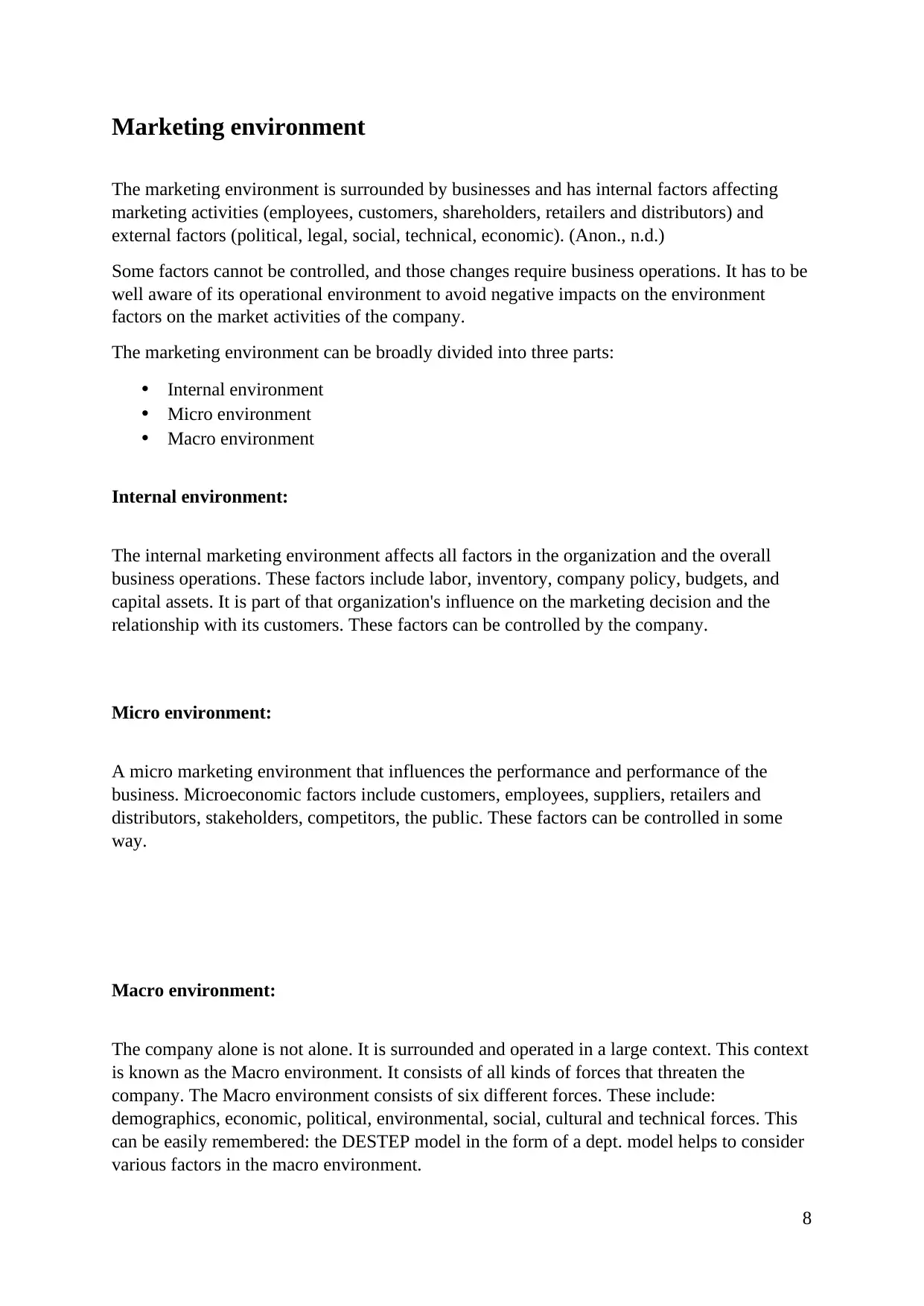
8
Marketing environment
The marketing environment is surrounded by businesses and has internal factors affecting
marketing activities (employees, customers, shareholders, retailers and distributors) and
external factors (political, legal, social, technical, economic). (Anon., n.d.)
Some factors cannot be controlled, and those changes require business operations. It has to be
well aware of its operational environment to avoid negative impacts on the environment
factors on the market activities of the company.
The marketing environment can be broadly divided into three parts:
• Internal environment
• Micro environment
• Macro environment
Internal environment:
The internal marketing environment affects all factors in the organization and the overall
business operations. These factors include labor, inventory, company policy, budgets, and
capital assets. It is part of that organization's influence on the marketing decision and the
relationship with its customers. These factors can be controlled by the company.
Micro environment:
A micro marketing environment that influences the performance and performance of the
business. Microeconomic factors include customers, employees, suppliers, retailers and
distributors, stakeholders, competitors, the public. These factors can be controlled in some
way.
Macro environment:
The company alone is not alone. It is surrounded and operated in a large context. This context
is known as the Macro environment. It consists of all kinds of forces that threaten the
company. The Macro environment consists of six different forces. These include:
demographics, economic, political, environmental, social, cultural and technical forces. This
can be easily remembered: the DESTEP model in the form of a dept. model helps to consider
various factors in the macro environment.
Marketing environment
The marketing environment is surrounded by businesses and has internal factors affecting
marketing activities (employees, customers, shareholders, retailers and distributors) and
external factors (political, legal, social, technical, economic). (Anon., n.d.)
Some factors cannot be controlled, and those changes require business operations. It has to be
well aware of its operational environment to avoid negative impacts on the environment
factors on the market activities of the company.
The marketing environment can be broadly divided into three parts:
• Internal environment
• Micro environment
• Macro environment
Internal environment:
The internal marketing environment affects all factors in the organization and the overall
business operations. These factors include labor, inventory, company policy, budgets, and
capital assets. It is part of that organization's influence on the marketing decision and the
relationship with its customers. These factors can be controlled by the company.
Micro environment:
A micro marketing environment that influences the performance and performance of the
business. Microeconomic factors include customers, employees, suppliers, retailers and
distributors, stakeholders, competitors, the public. These factors can be controlled in some
way.
Macro environment:
The company alone is not alone. It is surrounded and operated in a large context. This context
is known as the Macro environment. It consists of all kinds of forces that threaten the
company. The Macro environment consists of six different forces. These include:
demographics, economic, political, environmental, social, cultural and technical forces. This
can be easily remembered: the DESTEP model in the form of a dept. model helps to consider
various factors in the macro environment.
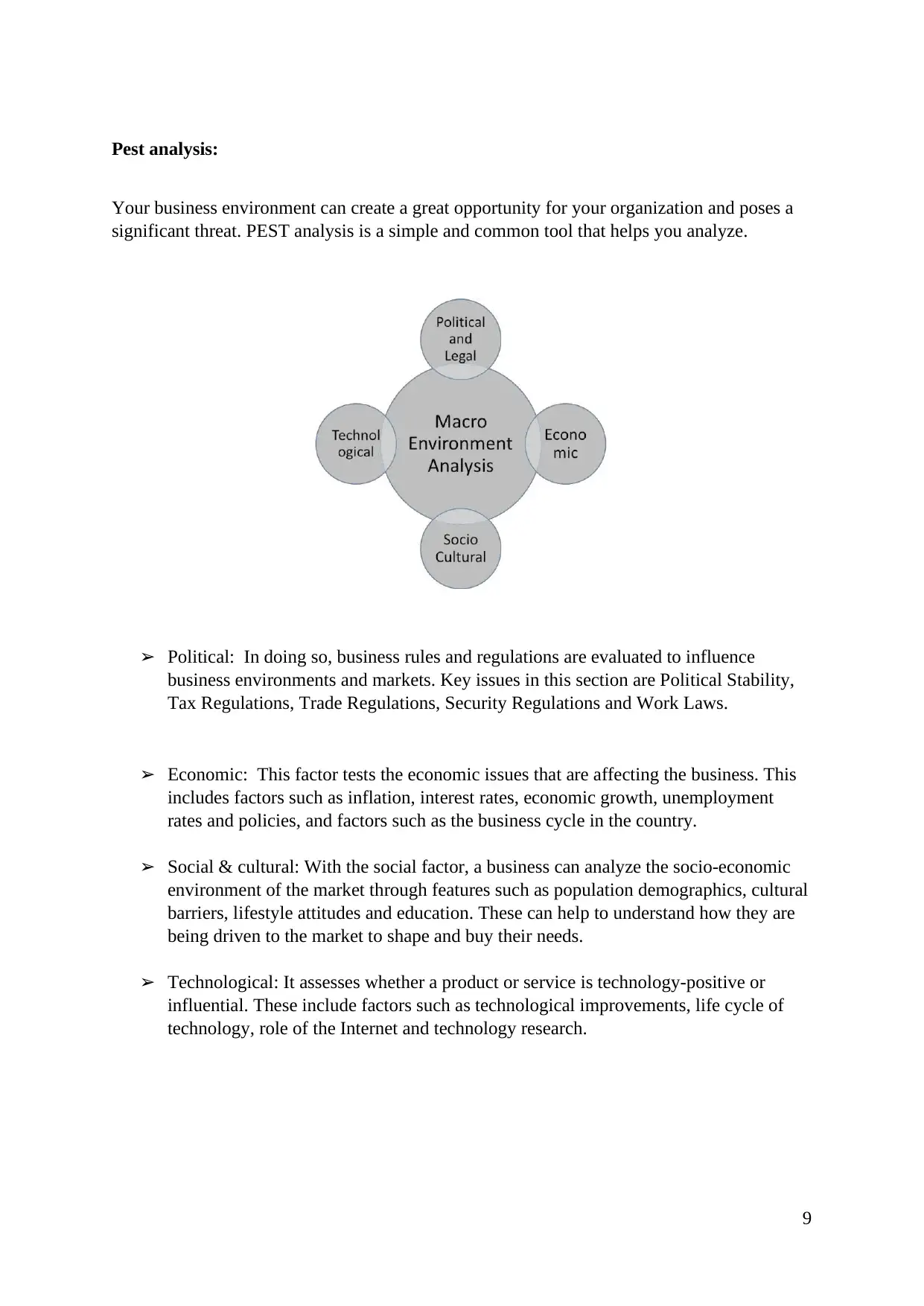
9
Pest analysis:
Your business environment can create a great opportunity for your organization and poses a
significant threat. PEST analysis is a simple and common tool that helps you analyze.
➢ Political: In doing so, business rules and regulations are evaluated to influence
business environments and markets. Key issues in this section are Political Stability,
Tax Regulations, Trade Regulations, Security Regulations and Work Laws.
➢ Economic: This factor tests the economic issues that are affecting the business. This
includes factors such as inflation, interest rates, economic growth, unemployment
rates and policies, and factors such as the business cycle in the country.
➢ Social & cultural: With the social factor, a business can analyze the socio-economic
environment of the market through features such as population demographics, cultural
barriers, lifestyle attitudes and education. These can help to understand how they are
being driven to the market to shape and buy their needs.
➢ Technological: It assesses whether a product or service is technology-positive or
influential. These include factors such as technological improvements, life cycle of
technology, role of the Internet and technology research.
Pest analysis:
Your business environment can create a great opportunity for your organization and poses a
significant threat. PEST analysis is a simple and common tool that helps you analyze.
➢ Political: In doing so, business rules and regulations are evaluated to influence
business environments and markets. Key issues in this section are Political Stability,
Tax Regulations, Trade Regulations, Security Regulations and Work Laws.
➢ Economic: This factor tests the economic issues that are affecting the business. This
includes factors such as inflation, interest rates, economic growth, unemployment
rates and policies, and factors such as the business cycle in the country.
➢ Social & cultural: With the social factor, a business can analyze the socio-economic
environment of the market through features such as population demographics, cultural
barriers, lifestyle attitudes and education. These can help to understand how they are
being driven to the market to shape and buy their needs.
➢ Technological: It assesses whether a product or service is technology-positive or
influential. These include factors such as technological improvements, life cycle of
technology, role of the Internet and technology research.
⊘ This is a preview!⊘
Do you want full access?
Subscribe today to unlock all pages.

Trusted by 1+ million students worldwide
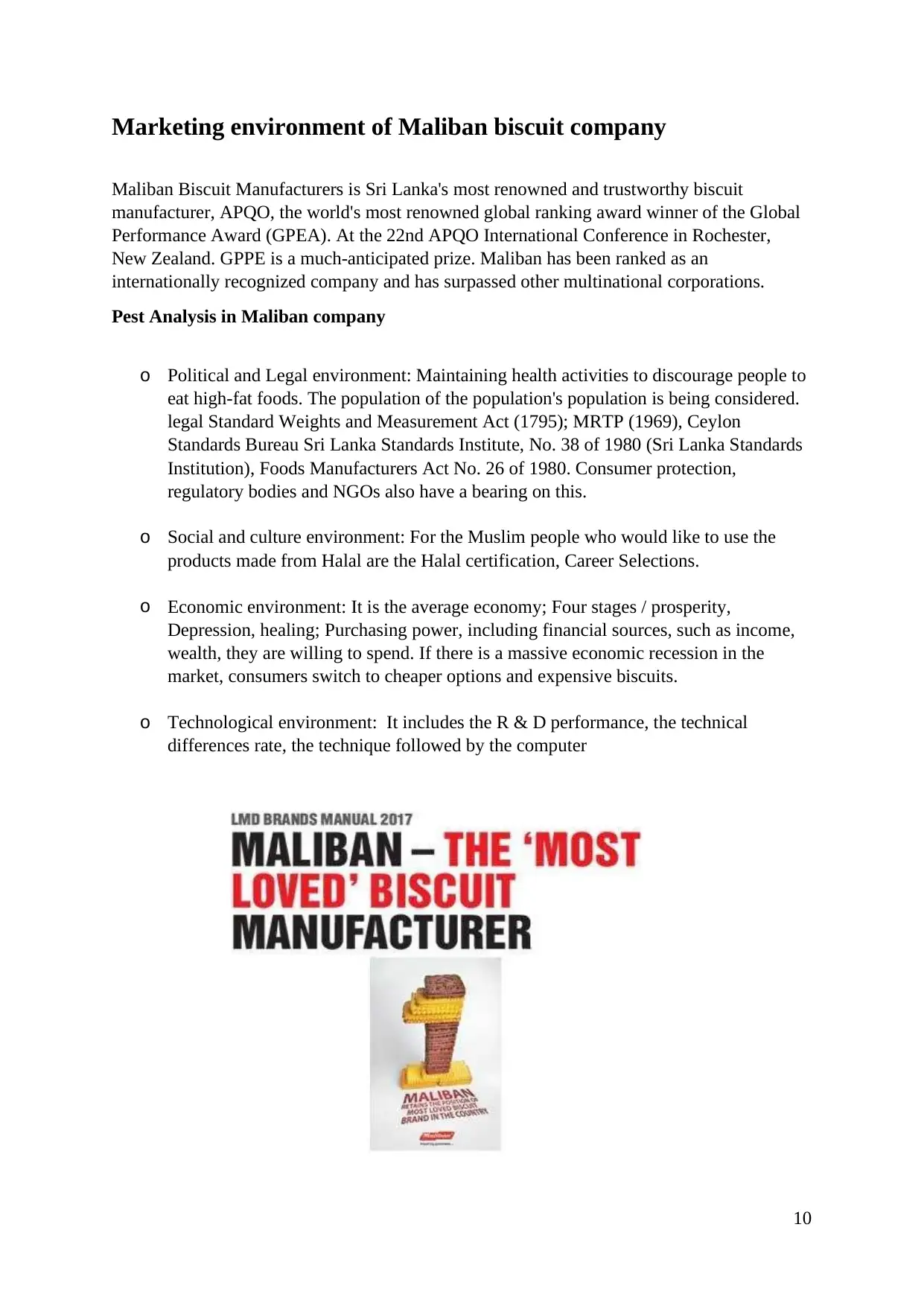
10
Marketing environment of Maliban biscuit company
Maliban Biscuit Manufacturers is Sri Lanka's most renowned and trustworthy biscuit
manufacturer, APQO, the world's most renowned global ranking award winner of the Global
Performance Award (GPEA). At the 22nd APQO International Conference in Rochester,
New Zealand. GPPE is a much-anticipated prize. Maliban has been ranked as an
internationally recognized company and has surpassed other multinational corporations.
Pest Analysis in Maliban company
o Political and Legal environment: Maintaining health activities to discourage people to
eat high-fat foods. The population of the population's population is being considered.
legal Standard Weights and Measurement Act (1795); MRTP (1969), Ceylon
Standards Bureau Sri Lanka Standards Institute, No. 38 of 1980 (Sri Lanka Standards
Institution), Foods Manufacturers Act No. 26 of 1980. Consumer protection,
regulatory bodies and NGOs also have a bearing on this.
o Social and culture environment: For the Muslim people who would like to use the
products made from Halal are the Halal certification, Career Selections.
o Economic environment: It is the average economy; Four stages / prosperity,
Depression, healing; Purchasing power, including financial sources, such as income,
wealth, they are willing to spend. If there is a massive economic recession in the
market, consumers switch to cheaper options and expensive biscuits.
o Technological environment: It includes the R & D performance, the technical
differences rate, the technique followed by the computer
Marketing environment of Maliban biscuit company
Maliban Biscuit Manufacturers is Sri Lanka's most renowned and trustworthy biscuit
manufacturer, APQO, the world's most renowned global ranking award winner of the Global
Performance Award (GPEA). At the 22nd APQO International Conference in Rochester,
New Zealand. GPPE is a much-anticipated prize. Maliban has been ranked as an
internationally recognized company and has surpassed other multinational corporations.
Pest Analysis in Maliban company
o Political and Legal environment: Maintaining health activities to discourage people to
eat high-fat foods. The population of the population's population is being considered.
legal Standard Weights and Measurement Act (1795); MRTP (1969), Ceylon
Standards Bureau Sri Lanka Standards Institute, No. 38 of 1980 (Sri Lanka Standards
Institution), Foods Manufacturers Act No. 26 of 1980. Consumer protection,
regulatory bodies and NGOs also have a bearing on this.
o Social and culture environment: For the Muslim people who would like to use the
products made from Halal are the Halal certification, Career Selections.
o Economic environment: It is the average economy; Four stages / prosperity,
Depression, healing; Purchasing power, including financial sources, such as income,
wealth, they are willing to spend. If there is a massive economic recession in the
market, consumers switch to cheaper options and expensive biscuits.
o Technological environment: It includes the R & D performance, the technical
differences rate, the technique followed by the computer
Paraphrase This Document
Need a fresh take? Get an instant paraphrase of this document with our AI Paraphraser
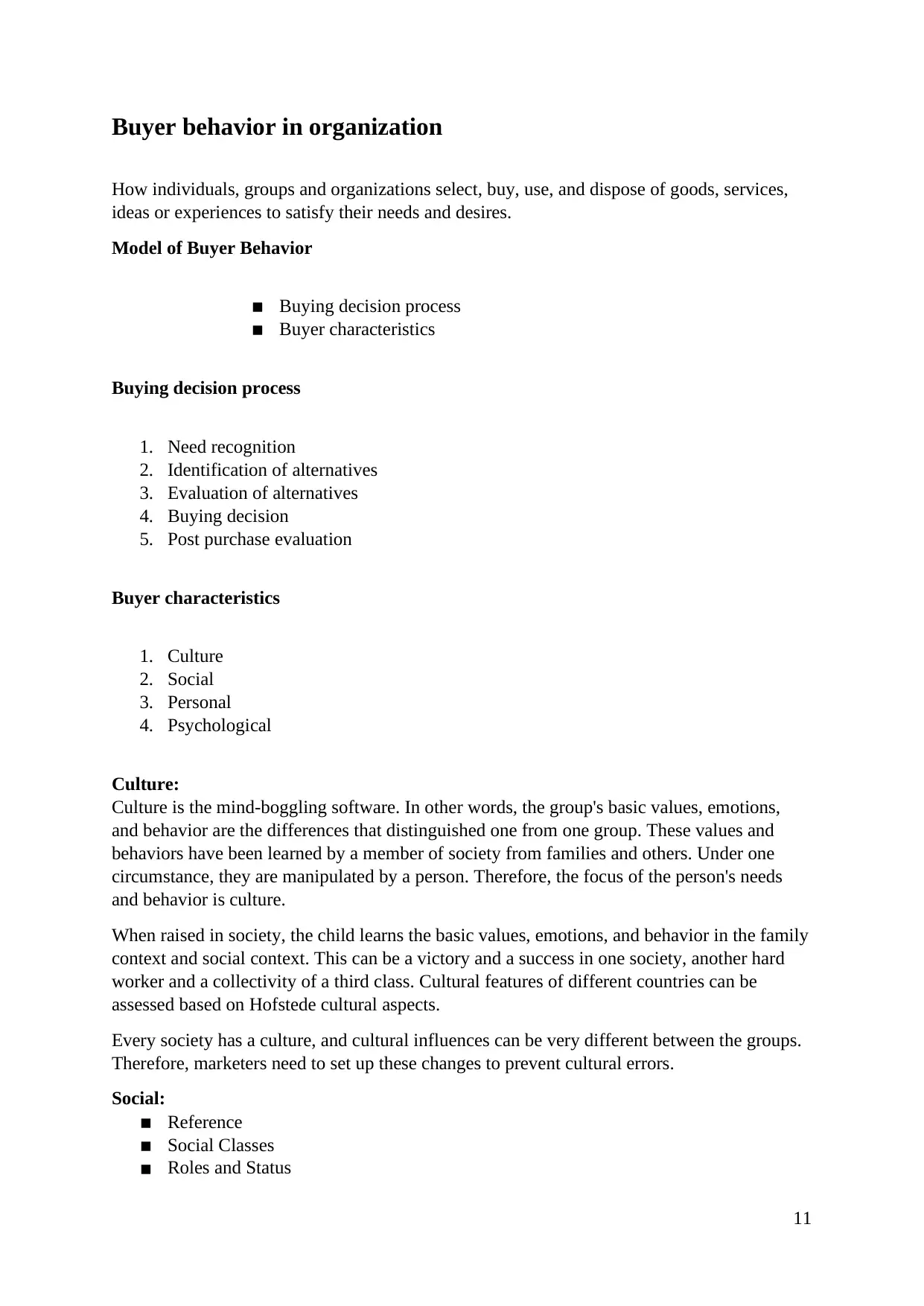
11
Buyer behavior in organization
How individuals, groups and organizations select, buy, use, and dispose of goods, services,
ideas or experiences to satisfy their needs and desires.
Model of Buyer Behavior
▪ Buying decision process
▪ Buyer characteristics
Buying decision process
1. Need recognition
2. Identification of alternatives
3. Evaluation of alternatives
4. Buying decision
5. Post purchase evaluation
Buyer characteristics
1. Culture
2. Social
3. Personal
4. Psychological
Culture:
Culture is the mind-boggling software. In other words, the group's basic values, emotions,
and behavior are the differences that distinguished one from one group. These values and
behaviors have been learned by a member of society from families and others. Under one
circumstance, they are manipulated by a person. Therefore, the focus of the person's needs
and behavior is culture.
When raised in society, the child learns the basic values, emotions, and behavior in the family
context and social context. This can be a victory and a success in one society, another hard
worker and a collectivity of a third class. Cultural features of different countries can be
assessed based on Hofstede cultural aspects.
Every society has a culture, and cultural influences can be very different between the groups.
Therefore, marketers need to set up these changes to prevent cultural errors.
Social:
▪ Reference
▪ Social Classes
▪ Roles and Status
Buyer behavior in organization
How individuals, groups and organizations select, buy, use, and dispose of goods, services,
ideas or experiences to satisfy their needs and desires.
Model of Buyer Behavior
▪ Buying decision process
▪ Buyer characteristics
Buying decision process
1. Need recognition
2. Identification of alternatives
3. Evaluation of alternatives
4. Buying decision
5. Post purchase evaluation
Buyer characteristics
1. Culture
2. Social
3. Personal
4. Psychological
Culture:
Culture is the mind-boggling software. In other words, the group's basic values, emotions,
and behavior are the differences that distinguished one from one group. These values and
behaviors have been learned by a member of society from families and others. Under one
circumstance, they are manipulated by a person. Therefore, the focus of the person's needs
and behavior is culture.
When raised in society, the child learns the basic values, emotions, and behavior in the family
context and social context. This can be a victory and a success in one society, another hard
worker and a collectivity of a third class. Cultural features of different countries can be
assessed based on Hofstede cultural aspects.
Every society has a culture, and cultural influences can be very different between the groups.
Therefore, marketers need to set up these changes to prevent cultural errors.
Social:
▪ Reference
▪ Social Classes
▪ Roles and Status
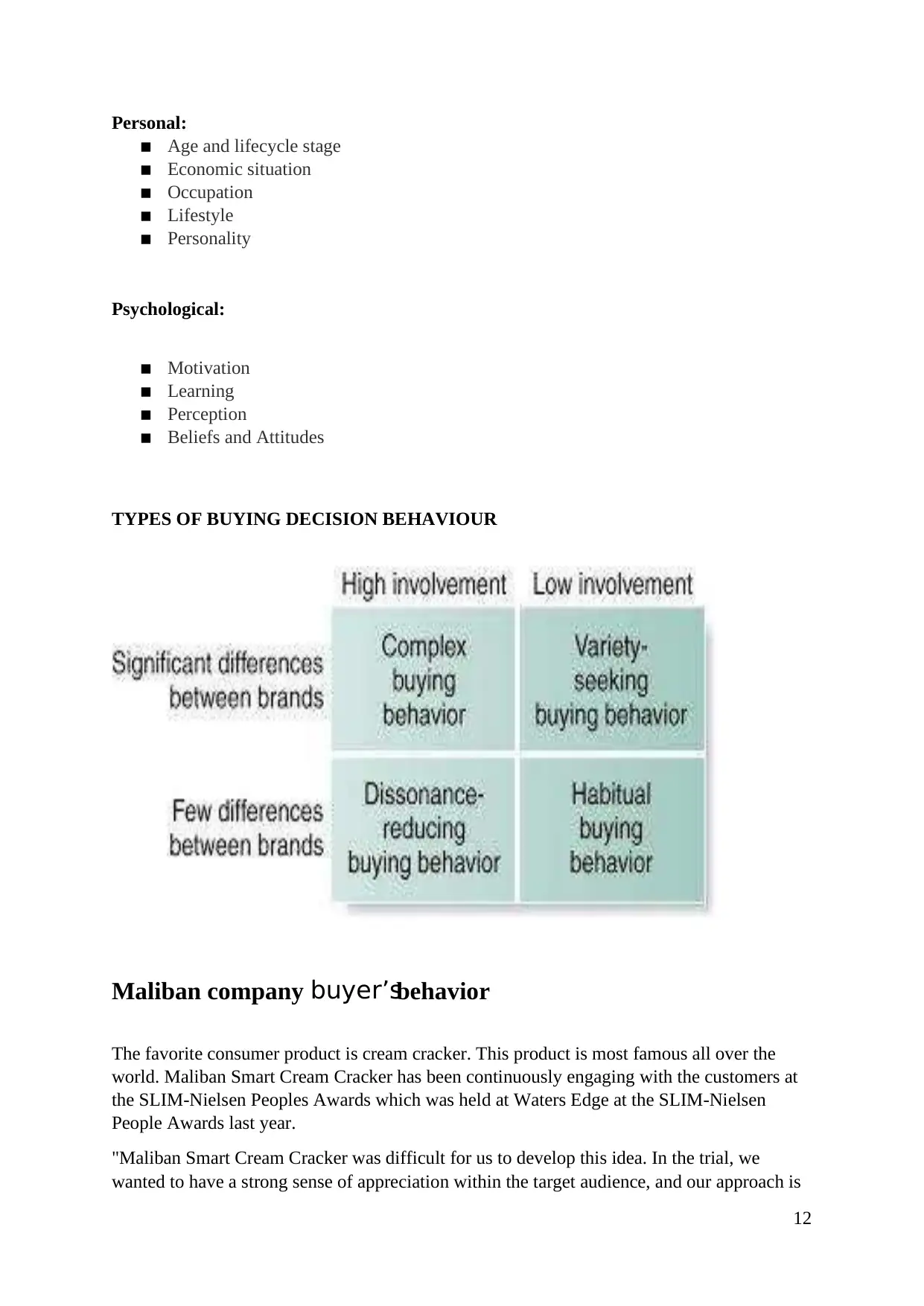
12
Personal:
▪ Age and lifecycle stage
▪ Economic situation
▪ Occupation
▪ Lifestyle
▪ Personality
Psychological:
▪ Motivation
▪ Learning
▪ Perception
▪ Beliefs and Attitudes
TYPES OF BUYING DECISION BEHAVIOUR
Maliban company buyer’sbehavior
The favorite consumer product is cream cracker. This product is most famous all over the
world. Maliban Smart Cream Cracker has been continuously engaging with the customers at
the SLIM-Nielsen Peoples Awards which was held at Waters Edge at the SLIM-Nielsen
People Awards last year.
"Maliban Smart Cream Cracker was difficult for us to develop this idea. In the trial, we
wanted to have a strong sense of appreciation within the target audience, and our approach is
Personal:
▪ Age and lifecycle stage
▪ Economic situation
▪ Occupation
▪ Lifestyle
▪ Personality
Psychological:
▪ Motivation
▪ Learning
▪ Perception
▪ Beliefs and Attitudes
TYPES OF BUYING DECISION BEHAVIOUR
Maliban company buyer’sbehavior
The favorite consumer product is cream cracker. This product is most famous all over the
world. Maliban Smart Cream Cracker has been continuously engaging with the customers at
the SLIM-Nielsen Peoples Awards which was held at Waters Edge at the SLIM-Nielsen
People Awards last year.
"Maliban Smart Cream Cracker was difficult for us to develop this idea. In the trial, we
wanted to have a strong sense of appreciation within the target audience, and our approach is
⊘ This is a preview!⊘
Do you want full access?
Subscribe today to unlock all pages.

Trusted by 1+ million students worldwide
1 out of 18
Your All-in-One AI-Powered Toolkit for Academic Success.
+13062052269
info@desklib.com
Available 24*7 on WhatsApp / Email
![[object Object]](/_next/static/media/star-bottom.7253800d.svg)
Unlock your academic potential
Copyright © 2020–2025 A2Z Services. All Rights Reserved. Developed and managed by ZUCOL.


